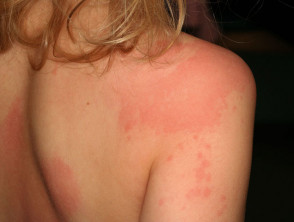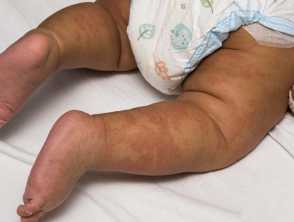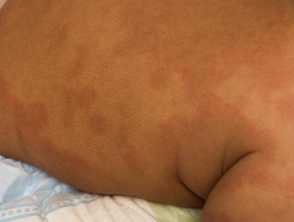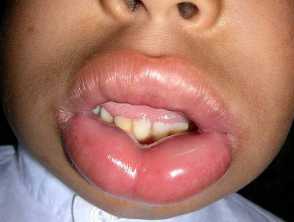What is urticaria in children?
Urticaria refers to a group of conditions in which weals (hives) or angioedema (swelling) develop in the skin. It is very common in children.
A weal is a superficial swelling, usually pale or skin-coloured. It is often surrounded by an area of erythema and can last from a few minutes to 24 hours. Children will usually complain of itch and sometimes of a burning sensation.
Angioedema is a deeper swelling from within the skin or mucous membranes. It usually looks red and puffy. The most common areas for angioedema in children are the lips, tongue, and eyelids.
Urticaria in children
How is urticaria in children classified?
Urticaria in children can be either acute (often gone within hours to days) or chronic (lasting longer than 6 weeks). In children, acute urticaria is much more common than chronic urticaria. About 40% of children with acute urticaria also have angioedema.
Chronic urticaria can be spontaneous (when weals occur without any specific trigger) or inducible (when weals occur with a specific trigger).
Chronic inducible urticaria is classified by the various physical triggers, such as dermographism (stroking or scratching the skin).
Which children get urticaria?
Approximately 15% of all children under 10 years of age will have at least one episode of acute urticaria. The risk is slightly higher for girls than for boys. However, if a child is atopic (has asthma, dermatitis, and allergies), this risk is around 20%.
What causes urticaria in children?
Weals are caused by a number of chemical mediators, such as histamine and cytokines, which are released from inflammatory cells, including mast cells. The mediators cause vasodilation and leakage of fluid into surrounding tissues to produce the redness and swelling of urticarial weals.
Triggers of acute spontaneous urticaria can include:
- Viral infection (in 40% of cases), such as upper respiratory tract infection, viral hepatitis, or glandular fever (infectious mononucleosis)
- Bacterial infection, such as sinusitis or a dental abscess
- Food allergy, usually on or after the first exposure to a particular food such as egg, milk, soy, peanut, and wheat
- Drug-induced urticaria, such as that caused by an antibiotic or nonsteroidal anti-inflammatory drug (NSAID)
- Bee or wasp sting.
There is no obvious trigger in approximately 50% of cases of acute urticaria. This may be called ‘idiopathic’ urticaria.
Chronic urticaria is usually caused by autoimmunity or a chronic underlying infection. It is rare in children.
Inducible urticaria is caused by a direct stimulus, such as dermographism, delayed pressure, cold, heat, sunlight, vibration, or exercise. It is linked with atopy and chronic urticaria, but the pathogenesis is not fully understood.
What are the clinical features of urticaria in children?
Urticarial weals may appear on any part of the body and are often very itchy. They can vary in size from the size of a pinpoint to several centimetres in diameter. They are either white or red and can be either localised or widespread. Weals change shape and size and each one lasts from a few minutes to several hours.
Angioedema is usually localised to a single area such as the hands, feet, and genitalia. It most commonly affects the face in children. The child may have a swollen tongue, eyelids, or lips. Angioedema is often tender or painful.
Inducible urticaria due to a physical stimulus often comes on within minutes after exposure and resolves in less than an hour. The weals will be localised to the exposed site. Angioedema is exceptionally rare in these cases.
Urticaria and angioedema in children
What are the complications of urticaria in children?
Urticaria is usually self-limiting and will go away on its own. However, it can often be very uncomfortable for a child due to the intense itchiness. There are usually no serious long-term consequences for children.
Urticaria may be a component of anaphylaxis (severe allergic response). If the child is also struggling to breathe, wheezing, collapses, or seems unwell, seek urgent medical attention.
How is urticaria in children diagnosed?
Urticaria is usually diagnosed by taking a medical history. Urticaria is characterised by individual weals resolving or changing within 24 hours. The child should be thoroughly examined to detect possible causes.
If a food or drug allergy is suspected, a skin prick test or immunoglobulin E (IgE) tests may occasionally be arranged to investigate further.
What is the differential diagnosis for urticaria in children?
The differential diagnosis for urticaria in children includes a variety of infections and skin conditions.
- Insect bites — these present on exposed sites, such as the waistline or ankles, as asymmetrical clusters of itchy papules or weals, often with a central fluid-filled blister. The lesions persist for several days or longer.
- Contact dermatitis — this presents on areas in contact with a causative irritant or allergen with irregular, red, blistered, scaly, sometimes swollen, plaques. Dermatitis persists for days to weeks, much longer than urticarial weals.
- Erythema multiforme — erythematous plaques are usually located on acral sites (the hands, arms, feet, legs, or face). Target lesions (a pattern of concentric rings) are characteristic, sometimes with central blistering. Each plaque persists days to weeks.
- Urticarial vasculitis — this is uncommon. It resembles urticaria with the exception that for the weals last longer than 24 hours and are followed by bruise-like discolouration.
What is the treatment for urticaria in children?
Urticaria in children is treated with a non-sedating antihistamine, such as cetirizine. This is not curative, but often controls the itch and the spread of weals until the urticaria settles on its own.
Dosage recommendations based on age groups are as follows:
- Babies and infants aged under 2 years — 1 mL of cetirizine oral solution per 4 kg twice per daily
- Children aged 2–6 years — 2.5 mL of cetirizine oral solution twice daily
- Children aged 6–12 years — a 10-mg cetirizine tablet once daily or 10 mL of cetirizine oral solution once daily.
In severe cases that are unresponsive to antihistamines, oral prednisone may be given for a few days.
Children may also be advised to avoid triggers such as foods or drugs, cold or heat.
The itch may be reduced by cooling with a fan, ice pack, or moisturising lotion.
If there is life-threatening anaphylaxis, an intramuscular injection of adrenaline is advised.



